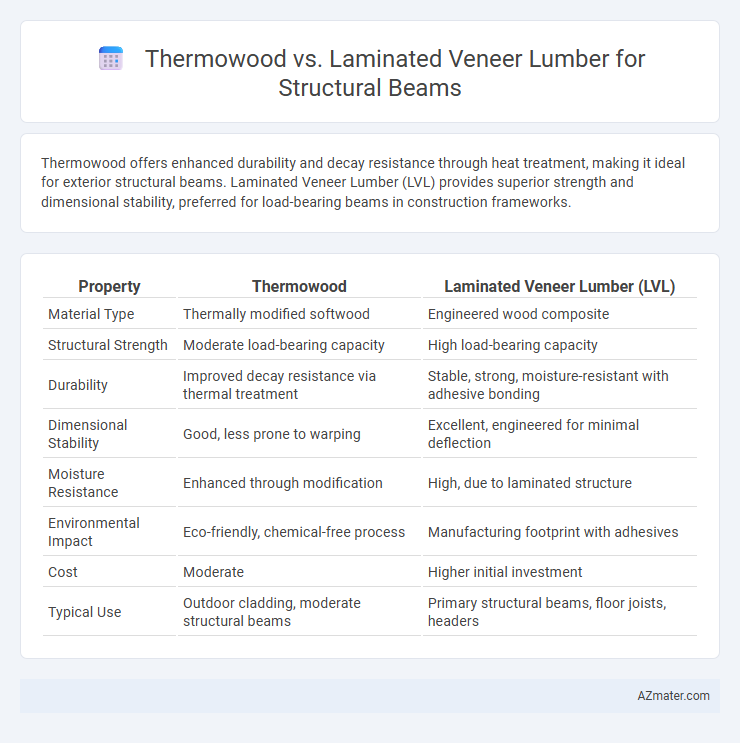Thermowood offers enhanced durability and decay resistance through heat treatment, making it ideal for exterior structural beams. Laminated Veneer Lumber (LVL) provides superior strength and dimensional stability, preferred for load-bearing beams in construction frameworks.
Table of Comparison
| Property | Thermowood | Laminated Veneer Lumber (LVL) |
|---|---|---|
| Material Type | Thermally modified softwood | Engineered wood composite |
| Structural Strength | Moderate load-bearing capacity | High load-bearing capacity |
| Durability | Improved decay resistance via thermal treatment | Stable, strong, moisture-resistant with adhesive bonding |
| Dimensional Stability | Good, less prone to warping | Excellent, engineered for minimal deflection |
| Moisture Resistance | Enhanced through modification | High, due to laminated structure |
| Environmental Impact | Eco-friendly, chemical-free process | Manufacturing footprint with adhesives |
| Cost | Moderate | Higher initial investment |
| Typical Use | Outdoor cladding, moderate structural beams | Primary structural beams, floor joists, headers |
Introduction to Structural Beam Materials
Thermowood and Laminated Veneer Lumber (LVL) are prominent structural beam materials used in modern construction, each offering distinct mechanical properties. Thermowood, a heat-treated timber, provides enhanced durability, resistance to decay, and dimensional stability, making it ideal for outdoor and moisture-prone applications. LVL, composed of multiple thin wood veneers bonded under heat and pressure, delivers superior strength, uniformity, and load-bearing capacity, favoring large-span beams and load-intensive structures.
What is Thermowood?
Thermowood is a type of heat-treated timber processed at high temperatures to enhance durability, dimensional stability, and resistance to decay and insects, making it ideal for structural applications. Unlike Laminated Veneer Lumber (LVL), which is engineered by bonding thin wood veneers under heat and pressure for uniform strength, Thermowood retains its natural wood structure but gains improved performance characteristics through thermal modification. Its eco-friendly treatment process and enhanced weather resistance make Thermowood a sustainable and reliable choice for beams in both exterior and interior construction projects.
What is Laminated Veneer Lumber (LVL)?
Laminated Veneer Lumber (LVL) is an engineered wood product made by bonding thin wood veneers together under heat and pressure, producing a strong, uniform structural beam ideal for load-bearing applications. It offers consistent strength, dimensional stability, and resistance to warping compared to solid or thermally modified wood like Thermowood. LVL's engineered construction enables it to support heavy loads over long spans, making it a preferred choice for structural beams in construction and architectural projects.
Strength and Load-Bearing Capacity Comparison
Thermowood, produced through heat treatment of softwood, enhances dimensional stability and resistance to decay but generally exhibits lower tensile strength compared to Laminated Veneer Lumber (LVL), which is engineered from thin wood veneers bonded under heat and pressure for superior uniformity and high load-bearing capacity. LVL demonstrates greater strength-to-weight ratio and stiffness, making it ideal for structural beams in heavy-load scenarios where consistent performance under stress is critical. While Thermowood offers improved durability for exterior applications, LVL remains the preferred choice in construction projects requiring maximum structural strength and reliable load distribution.
Durability and Weather Resistance
Thermowood offers superior durability and weather resistance due to its enhanced dimensional stability and natural resistance to fungal decay, making it ideal for outdoor structural beams exposed to varying climates. Laminated Veneer Lumber (LVL), while strong and engineered for uniformity, is typically more susceptible to moisture-related degradation unless properly sealed and maintained. Choosing Thermowood can reduce long-term maintenance costs and improve the lifespan of structural beams in moisture-prone environments.
Thermal Insulation Properties
Thermowood offers superior thermal insulation properties due to its modified wood structure, which reduces thermal conductivity and enhances energy efficiency in structural beams. Laminated Veneer Lumber (LVL), while providing exceptional strength and uniformity, generally exhibits higher thermal conductivity, making it less effective in insulating applications compared to Thermowood. Choosing Thermowood for structural beams contributes to improved thermal performance in buildings, reducing heat loss and energy consumption.
Sustainability and Environmental Impact
Thermowood beams are produced through heat treatment of timber, enhancing durability without chemical additives, resulting in a low environmental footprint and excellent resistance to decay and insects. Laminated Veneer Lumber (LVL) combines multiple wood veneers bonded with adhesives, utilizing smaller, fast-growing trees efficiently, but the production involves synthetic resins that may off-gas volatile organic compounds (VOCs). Thermowood offers a more natural, chemical-free option aligned with sustainable forestry practices, while LVL supports resource optimization but requires consideration of adhesive-related emissions in structural applications.
Cost and Economic Considerations
Thermowood generally incurs higher upfront costs due to its specialized heat treatment process, but offers enhanced durability and resistance to decay, reducing long-term maintenance expenses. Laminated Veneer Lumber (LVL) typically presents a more cost-effective option with consistent strength and dimensional stability, making it favorable for large-scale structural applications where budget constraints are critical. Evaluating lifecycle costs, including installation, durability, and potential replacement, is essential for making an economically sound choice between Thermowood and LVL for structural beams.
Applications in Construction
Thermowood offers enhanced durability and resistance to moisture, making it ideal for outdoor structural beams exposed to harsh weather conditions. Laminated Veneer Lumber (LVL), engineered for high strength and uniformity, is frequently used in load-bearing applications such as floor joists, roof beams, and long-span supports. Both materials improve structural performance, with Thermowood suited for eco-friendly, weather-resistant projects, while LVL excels in precision-engineered construction requiring consistent load capacity.
Choosing the Right Material for Your Project
Thermowood offers enhanced durability and resistance to decay through heat treatment, making it ideal for outdoor or moisture-prone structural beams. Laminated Veneer Lumber (LVL) provides superior strength and uniformity due to its engineered layering, suitable for heavy-load applications and long spans. Selecting between Thermowood and LVL depends on project requirements such as environmental exposure, load capacity, and longevity, ensuring the optimal balance of performance and cost-efficiency.

Infographic: Thermowood vs Laminated Veneer Lumber for Structural Beam
 azmater.com
azmater.com